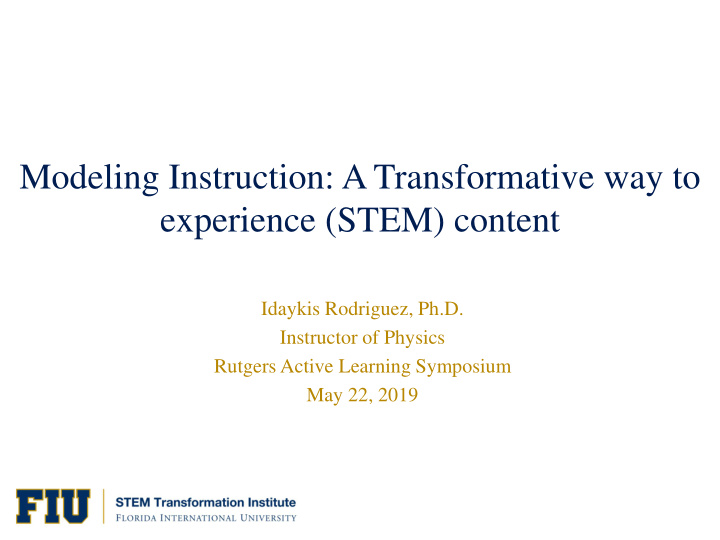



Modeling Instruction: A Transformative way to experience (STEM) content Idaykis Rodriguez, Ph.D. Instructor of Physics Rutgers Active Learning Symposium May 22, 2019
WELCOME TO INTRODUCTORY PHYSICS 2
Welcome to Introductory Physics • The course comprises both the “lecture” and “lab” components of introductory college physics; both have been integrated into a single studio-format course. • From the syllabus: – There is no lecture videos or textbook – Download and print the class materials on webpage – No grading curve – Success in this class is easy, come to class everyday and participate. 3
Activity: Model Airplane • Groups of 3-4 people • Each group has 3 sheets of paper – 1 for practice – 1 to create instructions on how to make your paper airplane – 1 to set aside for later • Create instructions to make a paper airplane 4
Reflection • What was difficult or challenging about writing the instructions? 5
Activity: Model Airplane • Redistribute sets of instructions from one group to another. • Use the 3 rd piece of paper to follow instructions. • Consider these questions: – What characteristics define an airplane? – Why would we have you do this activity? – What is a model? 6
THANK YOU! 7
Airplane Model Discussion • Why did we do this activity? aka What makes an airplane an airplane? – Assumptions • it has to fly, have wings? – Use of multiple representations increases communication • Use of diagrams and pictures instead of just words – Negotiating terms • Words like lengthwise and hot-dog style 9
Airplane Model Discussion • What is a model? What makes up a good model? What do we use models for? – A prototype – A particular design – A simplified description of a process or system – Something that predicts or explains 11
BREAKING DOWN MODELING INSTRUCTION 12
Modeling Instruction: Curriculum and Pedagogical designs • Modeling Instruction is both curricula and pedagogical approach that started in physics that centers on development and testing of conceptual models (Brewe & Sawtelle, 2018) . 13
Modeling Instruction: Core Goals • Answering two questions: – “What is science?” – “How do we engage students authentically in learning science?” 14
Modeling Cycle • Student-centered studio class Development • Student focus on small group work • Highly scaffold Revision Validation activities • Prepare whiteboards with Deployment their conceptual models (Brewe & Sawtelle 2018, Wells et al 1995, Brewe 2008, Hestenes 1987, Wells et al 1995, Desbien 2002, Halloun 2004, Durden et al 2012, 15 McPadden et al 2017)
Development in the classroom • Class starts with an experiment. • They use and develop representational tools. – System schema c Obj 2 Obj 1 c c g g Earth 16
Validation in the classroom • Students present their work in large whole class discussions. 17
Deployment in the classroom 18
IS THIS ACTUALLY EFFECTIVE? 19
Not possible without LA’s • Learning assistants (LAs) are student that have previously taken the course before and guide students through their learning activity. 20
• Public, Urban, R1 Research University in Miami • Hispanic serving institution • 83% commuter students • 79% students locally recruited 21
Modeling Instruction is Effective • Significant differences on FCI learning gains as compared to lecture courses • The odds of success in MI is 6.73 larger than lecture • Brewe E, Sawtelle V, Kramer L, O’Brien G, Rodriguez I and Pamelá P (2010), Phys. Rev. Spec. Top. Phys. Educ. Res. 6 22 010106
Positive attitudes towards physics • CLASS measures student attitudes towards science. • Most physics courses have a negative shift in attitudes • Modeling Instruction has positive shift is student attitudes towards physics. • Independent of instructor effect. These are six different instructors teaching Modeling. • Eric Brewe, Adrienne Traxler, Jorge de la Garza, and Laird H. Kramer, Phys. Rev. ST Phys. Educ. Res. 9, 020116 23
Success in upper level physics courses Rodriguez, I., Potvin, G., Kramer, L.H., 25 (Approved Phys. Rev. PER, 2016)
Success in Graduating with Physics Degree Rodriguez, I., Potvin, G., Kramer, L.H., (Approved Phys. Rev. PER, 2016) 26
Effects of Scaling up • Current Large Modeling Class learning effect is averaged at 1.28 (CI 1.13-1.44) • Historic Modeling effect is 1.41 (1.28,1.54) • Historic Lecture effect is 0.88 (0.81- 0.96) • Manuscript in preparation 27
Summary so far…. • Experienced a modeling activity • Introduced the mechanisms in the classrooms • Explored its effectiveness (for physics) 28
So what’s next? • Our group is developing Modeling instruction for other disciplines such as Calculus. • We have submitted an ISUE to modulate Modeling Instruction. (waiting to hear back) • My interests are with the students…. 29
Identity Development Cisgender female Latinx, Physics immigrant, undergraduate first gen major student Assets 30
31
32
THANK YOU QUESTIONS? 33
Recommend
More recommend